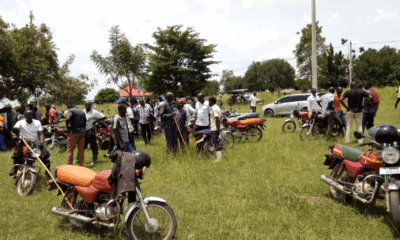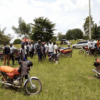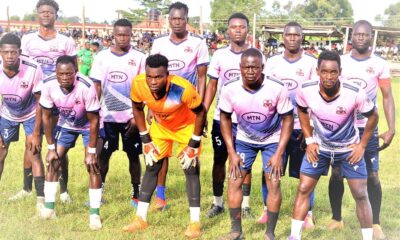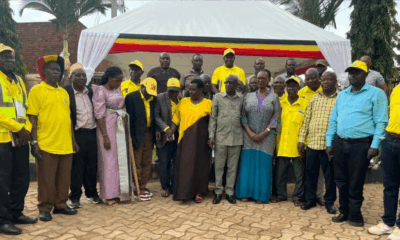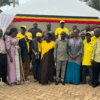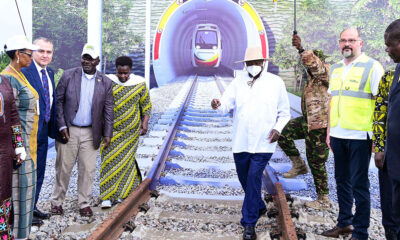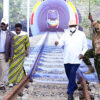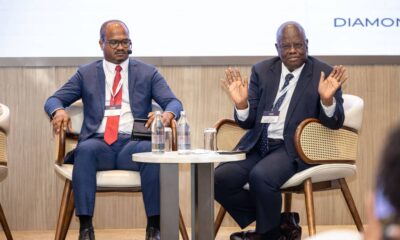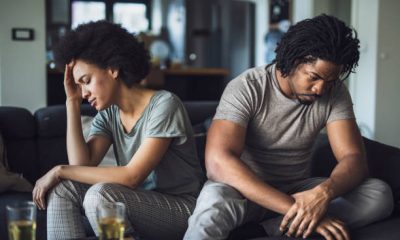Life & Style
Human trafficking: Tracing the route of death Via the infamous Lwakhakha border
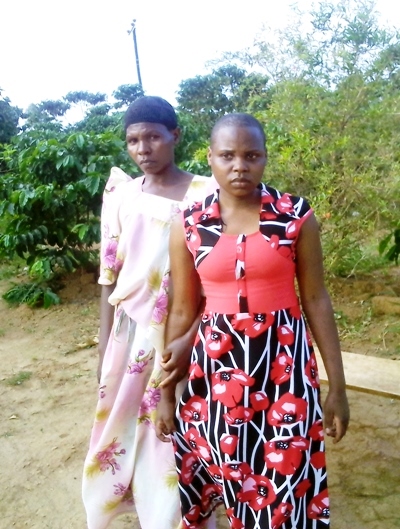
Nakiwunga-Sharon-and-her-mother
Sharon Josephine Nakiwunga, 22, in April 2018 went to Oman with the hope of making money to lift her family out of dire poverty. She, on two occasions, sent money back home; UGX 500,000 in May and UGX 600,000 in August in 2018. In May 2019 she was returned home broke and impaired.
Her speech is extremely slurred. She takes five minutes to utter a single word. A report from Masaka Hospital indicates that the doctors there could not identify her exact condition. But they said the cause was trauma.
“They hammered me on the head, denied me food and pinned me to cold metals at night. They injected me with substances I could not understand,” she told me when I visited her home in Kyabakuza, Lwengo district.
Nakiwunga was trafficked out of Uganda through a ghost labour recruitment agency called Aljazeera International Services. Her father Joseph Katende paid UGX 700,000 to a one Sulaiman Katende, purporting to be an agent of the company, for the service. A case of illegal recruitment was filed against Katende at the Central Police Station in Kampala in January 2019 with reference number SD/45/23/01/2019. He was only briefly detained and eventually set free.
Christine Nambereke, another victim was allegedly trafficked out of Uganda by Stephen Kuremu, the former LC3 Chairperson of Bumbo Sub County, Namisindwa district, on September 18, 2018. She reportedly lost her life in April 2019 after allegedly being poisoned by her employers in Oman.
“Christine reached Oman as we had expected. She sent us money for the first three months and it instantly changed our lives. We thought our fortunes had changed. But that was short lived. She started sending videos that she was being overworked. She told us that she was working in two homes which wasn’t part of the contract. Then she told us she was being poisoned. The next thing we heard was that she had died,” narrated James Obed, the husband.
Human trafficking has become one of the most disturbing crimes in Uganda today. The traffickers know what they are doing. The victims are unsuspecting. The promise is always good salaries. The result is often forced labour and sexual exploitation.
Over the years the number of young people trafficked from Uganda to Asia, the Middle East as well as some African countries has been rising. They are promised earnings of between UGX 900,000 and UGX 4m, some descent pay compared to what an average Ugandan earns, but misery often lies in wait.
How they are trafficked
When she was brought to Kampala, Nakiwunga, narrates, she was taken to a house where she found many other girls. They were taken through some training involving personal conduct. They were transferred to Jinja, Mbale and finally to Lwakhakha border in eastern Uganda using hired public service vehicles.
At Lwakhakha the group was split. They would have to cross into Kenya individually, some via River Lwakhakha and others through the official Lwakhakha border gate.
“At the river I found boys waiting to direct me and I crossed through the water. They told me that once we were across in Kenya everything would be fine,” she narrates.
Katende, she said, remained in Lwakhakha town. He called later to confirm whether she had crossed safely. His part was done. In Kenya she found a waiting motorcycle that took her to a nearby town where she met the other girls.
Tracing the route
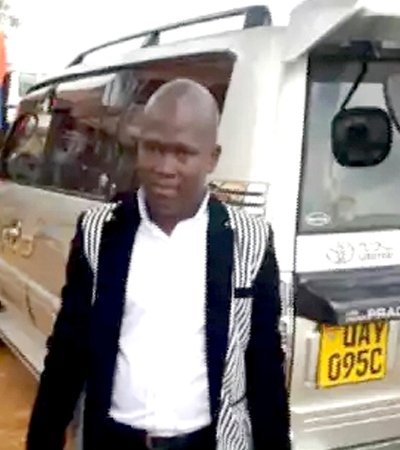
Katende the suspected trafficker
At 3:00am on June 30 I set foot in Mbale to trace Nakiwunga’s path. By 10:00am the following day I was at Magale town where I found a local leader, whose identity is kept anonymous for his safety, who was waiting to accompany me to Lwakhakha border, Namisindwa district.
Together we set off for the border on a motor bike. At Lwakhakha we met another local leader whose role was to guide us through the area.
Lwakhakha is a small town at Uganda’s border with Kenya. It is 55km from Mbale town. River Lwakhakha separates Uganda and Kenya. The Lwakhakha police station is right at the border.
Residents say that it is easy to cross the border as long as you are not carrying anything
“The security here only asks you questions if there is something you are carrying. If you are carrying nothing you just enter and exit freely,” one resident said.
To prove that this was true, I left my bag behind and crossed the border. No one asked me anything.
We afterwards followed a small pathway to the river. We then followed a path along the river bank that stretches several kilometers. I was shown the points on the river used by people to cross to and from both countries freely. These paths have rocks on which people can step as they wade through the water. I was shown twenty crossing points across two villages. No security is deployed either side of the border to guard those points. I crossed the border through nine of the twenty points.
At one of the points, a young man I found washing a bicycle told me that he makes some money through guiding the trafficked girls to cross the border.
“They find waiting motorcycles that take them either to Chwele to pick the Matatu which here we call taxis to take them to Bungoma where they board the bus that takes them to Nairobi or to Kimiri-Kitale where they board a passenger bus that goes to Nairobi,” a local leader who preferred to remain anonymous told me.
“Alternatively they use the Kenyan bus services here at Lwakhakha Kenya side. The bus sets off between 4:00 and 6:00pm depending on the seasons. The most popular one is Muvimirivu Bus Service,” he added.
Another local leader, who also preferred to remain anonymous, said that in Lwakhakha they never knew that human trafficking was a crime until the death of Nambereke.
“When they wanted to arrest the former chairperson of Bumbo that is when people got to know that it was a crime. Before that it was normal business,” he said.
Villages mentioned to be the most used by traffickers include Lukhuna, Lukooki (b) cell, Musimbi, Sabino, Habikeya, Bukokhowera, Ndali, Market and Muta cell
There are efforts by the government and nongovernmental organizations to stop human trafficking. But the vice keeps growing.
The 2018 Police Report indicates that 286 incidents related to trafficking in persons were registered during that year as compared to 177 in 2017 and 125 in 2016.
Records at the Ministry of Internal Affairs show that both internal and external human trafficking cases registered in 2018 were 650, nearly twice the number in 2017 which is 355.
Out of the 650 cases 286 were taken to court and at least 28 cases secured convictions.
The US Department of State 2017 Trafficking in Persons Report indicates that Uganda carried out 145 trafficking investigations that year, 52 prosecutions and 24 convictions compared to 114 investigations, 32 prosecutions and 16 convictions in 2016.
The majority of labour exports from Uganda are through the nearly 100 licensed companies. Between 20,000 and 30,000 Ugandans, however, enter the external labour market through illegal agencies and individuals, according to media reports.
The Ministry of Gender, Labour and Social Development regularized labour exports in 2015 under the Labour Externalisation Policy. Over 70,000 Ugandans were reported to have gone for work in the United Arab Emirates, Saudi Arabia, Jordan, Bahrain, Oman, Iraq, Qatar and Afghanistan by January 2019.
The International Labour Organization (ILO) estimates indicate that in 2017 there were 24.9 million victims of human trafficking worldwide. A 2014 report from the same organization indicates that human trafficking earns profits of roughly USD150 billion a year for traffickers.
Sexual exploitation is the most commonly identified form of human trafficking, according to the 2016 United Nations Office on Drugs and Crime (UNODC) Global Report on Trafficking, constituting up to 79 percent, followed by forced labour with 18 percent.
Activist blames authorities
Mwiza Mariam fighting for the rights of abused domestic workers in foreign countries
Mariam Mwiza, the Director of the Overseas Workers Voice Uganda, an NGO working to rescue external workers from abuse, says some security officials have helped keep the human trafficking vice alive and thriving.
She, for example, insists that the Namisindwa RDC Moses Kigai and the DPC Livingstone Ssendikadiwa have connived and hid Kuremu instead of letting him face the law.
“As we are talking the trafficker is in Bumbo but Police have failed to arrest him. The DPC said that he was stopped by the RDC from arresting him. This is the kind of environment we are working in,” she said.
Mwiza said that traffickers in Uganda earn between USD 4000 and USD 6000 per person they traffic and the agent in Oman is believed to be earning between USD 10,000 and USD 13000 per person.
When I contacted the RDC about the human trafficking problem via Lwakhakha he referred me to the DPC. The DPC said they were finding it difficult to police the river, which runs from Malaba.
“This is a small river which someone can cross within a minute especially during the dry season. The water level is low so it is easy for one to cross and people cross as individuals. They have also created their own bridges so it is difficult to detect each and every one,” he said.
He denied allegations that he was shielding Kuremu. “We are investigating the case. No one is hiding the suspect as Mariam alleges. A suspect who is at the border you cannot just go and pick him. When a person is on the run it is not a one day thing. If things go well we shall get him before the end of this week,” he said.
In 2013, UN member states adopted a resolution which designated July 30 as the World Day against Trafficking in Persons. This day was declared in order to ‘raise awareness of the situation of victims of human trafficking and for the promotion and protection of their rights.’
Kampala Authorities speak out
Moses Binoga Commissioner of Police Anti-Human Trafficking Task Force said that they are trying to sensitize the public through creating awareness about the dangers of human trafficking. “Currently we don’t have a Victim Protection Policy in the country, so what we are doing is to sensitise the community about the dangers of human trafficking because once a girl goes for work as a maid they sign contracts. To rescue her the employer demands compensation which we don’t have currently,” he said.
Comments



